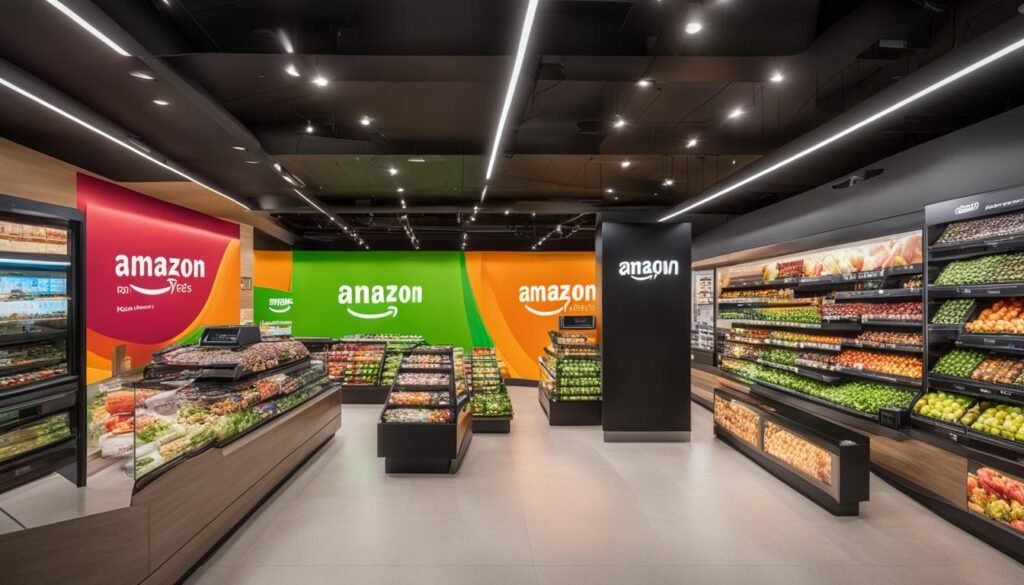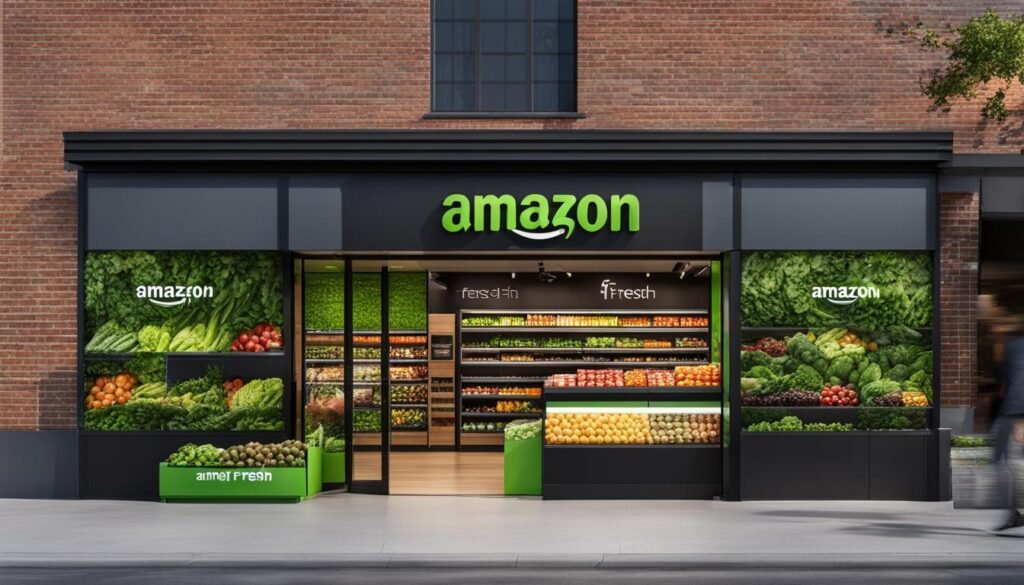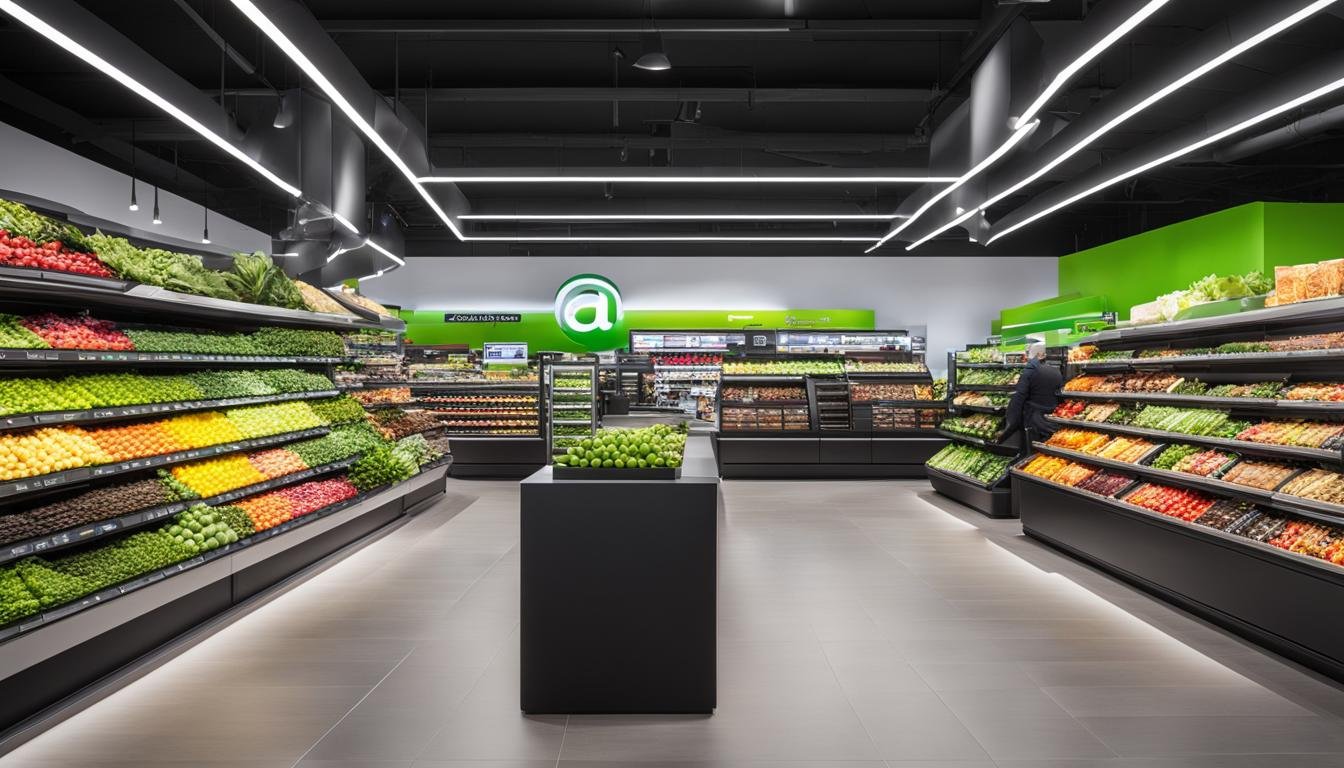Amazon Fresh is making significant strides in the e-commerce landscape, focusing on capturing a larger share of the grocery advertising market. Through the introduction of digital signage ads in Amazon Fresh stores and leveraging its Demand-Side Platform (DSP), the tech giant is offering brands innovative tools to advertise within their physical retail spaces. As a result, Amazon Fresh is attracting attention from major consumer packaged goods companies, such as Kraft Heinz, as they seek to benefit from the platform’s programmatic ad campaign capabilities, which are proven to drive impactful results.
Key Takeaways
- Amazon Fresh advertising aims to revolutionize the grocery advertising landscape with the implementation of digital signage ads in their physical stores.
- The tech giant utilizes its DSP to provide brands with advanced programmatic ad campaign tools, making it more attractive for key players in the grocery sector.
- Amazon Fresh’s focus on innovation and customer data insights offers more effective and relevant ad placements, catering to both online and offline sales channels.
- Major brands such as Kraft Heinz are taking note of the platform’s advertising achievements, with some experiencing substantial sales boosts as a result of their partnership.
- As Amazon Fresh continues to expand its advertising strategies and capabilities, it is well on its way to becoming a powerful force within the grocery retail space.
Amazon Fresh’s Evolution in the Grocery Advertising Space
Amazon has advanced its advertising capabilities by integrating digital signage in its Amazon Fresh store locations, available to eligible U.S. advertisers as of November. This strategic deployment allows brands to utilize Amazon’s programmatic ad tools within their physical stores, presenting a new frontier for grocery advertising. Utilizing digital signage, advertisers can capitalize on contextual targeting based on store location, product category, and time of day, thus creating more relevant and effective ad placements within the retail environment.
Integrating Digital Signage in Amazon Fresh Store Locations
Amazon Fresh grocery stores have integrated digital signage as a key marketing feature. These high-tech displays offer brands the opportunity to:
- Drive customer engagement
- Boost product visibility
- Effectively convey promotions and deals
With digital signage becoming a staple in Amazon Fresh stores, advertisers are provided with a comprehensive platform to showcase their ad products, making a substantial impact on the in-store shopping experience.
Roll-Out of Omnichannel Metrics for Enhanced Ad Impact Analysis
Amazon has fostered an innovative ecosystem for advertising analysis by launching omnichannel metrics for grocery and consumer packaged goods advertisers using Amazon DSP. This enables brands to see a combined interpretation of online and offline sales across diverse shopping channels, facilitating a comprehensive understanding of ad impact. With the introduction of automated budget optimization for campaign activities encompassing both online and offline sales, Amazon offers advertisers dynamic and responsive tools to guide their spending more efficiently based on real-time performance.
“Omnichannel metrics provide a holistic understanding of campaign performance and consumer behavior patterns, leading to well-informed marketing decisions.”
In conclusion, the integration of digital signage in Amazon Fresh grocery stores, coupled with the roll-out of omnichannel metrics, marks a significant evolution in the grocery advertising space. Amazon’s foray into advanced marketing techniques solidifies the company’s commitment to providing advertisers with powerful tools for promoting their products and services, while at the same time enhancing consumer experience within their physical stores.
Amazon’s Advertising Strategy for Grocery Brands
Amazon’s advertising strategy for grocery brands puts emphasis on testing and deploying digital ad campaigns in collaboration with grocery giants such as Kraft Heinz. By utilizing digital signage ad tests within the Amazon Fresh stores, brands can witness substantial sales uplift, signifying the benefits of Amazon’s approach and the opportunities for improved advertising performance in physical retail settings.
The introduction of omnichannel metrics through DSP reporting constitutes another essential component of Amazon’s strategy. By offering granular insights into how advertisements influence consumer purchases across sell multiple channels, Amazon ads provides advertisers with valuable data to enhance their campaigns.
Amazon’s advertising strategy for grocery brands focuses on testing and deploying digital ad campaigns in collaboration with grocery giants, as well as offering granular insights through DSP reporting and omnichannel metrics.
An example of Amazon’s successful advertising strategy is the collaboration with Kraft Heinz. A series of digital signage ad tests in Amazon Fresh stores led to increased sales for powdered beverage mixes, including popular brands such as Crystal Light, Mio Energy, and Kool-Aid. This demonstrates the potential for enhanced advertising performance in physical retail environments, thanks to Amazon’s innovative approach.
- Testing and deploying digital ad campaigns
- Collaborating with grocery giants like Kraft Heinz
- Leveraging omnichannel metrics through DSP reporting
Ultimately, Amazon’s advertising strategy aims to provide grocery brands with the tools and insights needed to optimize their ad campaigns and drive sales. By embracing innovations such as digital signage and leveraging data through omnichannel metrics and DSP reporting, Amazon is unlocking new opportunities for grocery brands in both online and offline spaces.
A Look Into Amazon’s Ad Product Launch and Grocery Sellers Collaboration

Amazon’s recent ad product launch highlights its collaboration with CPG giants, leveraging digital signage ads to drive increased sales in the grocery sector. Among the key partners in this endeavor is Kraft Heinz, with the trial of digital signage ads in Amazon Fresh stores resulting in a remarkable 40% sales increase for selected beverages within the beverage product category.
“The use of digital signage ads in Amazon Fresh stores showcases the powerful influence of strategically placed advertising within a retail environment, specifically driving a notable sales lift.”
Working alongside major CPG players enables Amazon to capitalize on the success of their advertising strategies, resulting in further opportunities for growth and development in the grocery sector.
Testing Digital Signage Ads with CPG Giants
Amazon has played an active role in testing digital signage ads with CPG giants, exemplified by its work with Kraft Heinz. The successful trial yielded a significant sales lift for certain beverages, revealing the potential impact of well-crafted and well-placed digital ads within Amazon Fresh store locations.
- Effectiveness of digital signage ads in driving sales
- Role of CPG giants in Amazon’s ad product testing and rollout
- Notable sales lift for Kraft Heinz beverages in trial
Optimizing Campaign Strategies with Amazon DSP
Amazon’s focus on optimizing campaign strategies has largely been achieved through the deployment of Amazon DSP, an advanced programmatic ad campaign tool. This platform has enabled grocery brands to develop and run ads more efficiently within Amazon Fresh stores, making real-time updates based on campaign performance and adjusting spending proactively using comprehensive outcome data.
| Advantages of Amazon DSP | Impact on Grocery Brands |
|---|---|
| Advanced programmatic ad campaigns | Ability to create and execute efficient advertisements |
| Real-time updates based on performance data | Agile adjustments to ongoing ad campaigns |
| Comprehensive outcome data for proactive spending adjustments | Optimized advertising budgets and ad targeting |
Through collaborative initiatives with CPG giants and the innovative use of Amazon DSP, the company is transforming the grocery sector by providing a cutting-edge advertising platform for brands to reach consumers and drive sales in a highly competitive marketplace.
Growth of Amazon’s Grocery Initiatives Beyond Delivery Services

Amazon Fresh has evolved far beyond its initial foray into grocery delivery. Over the past decade and with strategic investments, including the acquisition of Whole Foods, Amazon has broadened its grocery footprint to encompass physical Amazon Fresh stores, Prime Day sales for grocery items, and other initiatives that span both online and brick-and-mortar realms.
With the acquisition of Whole Foods, Amazon gained a significant presence in the physical retail sector, combining its e-commerce prowess with Whole Foods’ established reputation for high-quality products. The partnership has enabled Amazon to offer innovations like Prime member discounts and delivery services to Whole Foods customers. Furthermore, Amazon Fresh physical stores provide an accessible, budget-friendly alternative to Whole Foods, targeting a wider customer base looking for convenient shopping experiences.
“Amazon Fresh has evolved far beyond its initial foray into grocery delivery. Over the past decade and with strategic investments including the acquisition of Whole Foods, Amazon has broadened its grocery footprint to encompass physical Amazon Fresh stores, Prime Day sales for grocery items, and other initiatives that span both online and brick-and-mortar realms.”
Amazon’s multifaceted approach to grocery initiatives extends beyond physical stores and includes online shopping, delivery services, and exclusive sales events. Prime Day, for example, not only provides discounts for electronics and other products but also features deals on grocery items, catering to consumers looking to stock their pantries and save on everyday essentials.
- Acquisition of Whole Foods
- Physical Amazon Fresh Stores
- Prime Day deals on grocery items
- Integration of Amazon Fresh delivery services with Whole Foods
- Expanded selection of grocery items on Amazon.com
Amazon’s success in the grocery sector is primarily driven by its seamless integration of technology and data, which enhances the shopping experience for customers. It remains imperative for Amazon to continue investing in both online and offline grocery initiatives as consumers increasingly seek convenience and innovative shopping solutions.
Comparison with Major Grocery Rivals and Amazon’s Positioning

Analyzing Amazon’s positioning in the grocery market reveals the competitive landscape of Amazon versus major grocery rivals such as Walmart and Kroger. While Amazon’s efforts in digital signage ads and omnichannel metrics have propelled it to an innovative status, its competitors still hold a significant share of market influence and represent ongoing challenges to Amazon’s growth.
Analysts’ Perspectives on Amazon Versus Walmart and Kroger
As industry experts evaluate Amazon’s grocery strategies, they highlight that despite its intense focus and innovation in advertising, both Walmart and Kroger retain dominant market shares and influence in the grocery sphere. Both companies have been expanding their own advertising networks, generating hurdles for Amazon as it attempts to attract core grocery shoppers.
Amazon may be the king of e-commerce, but Walmart and Kroger remain key players in the US grocery industry, demonstrating an ongoing battle for market share.
It’s important to recognize the growing impact ad networks hold in the struggle between these grocery giants. In recent years, Walmart has expanded its advertising business, now known as Walmart Connect, to introduce new ad products, such as sponsored search and in-store digital signage ads. Similarly, Kroger has established its own media arm, Kroger Precision Marketing, offering services like audience targeting, programmatic media, and in-store media solutions.
| Company | Advertising Network | Services Offered |
|---|---|---|
| Amazon | Amazon Advertising | Digital signage ads, omnichannel metrics, DSP |
| Walmart | Walmart Connect | Sponsored search, in-store digital signage ads |
| Kroger | Kroger Precision Marketing | Audience targeting, programmatic media, in-store media solutions |
However, Amazon’s continued efforts in digital signage ads and omnichannel metrics position the company as an innovator capable of capturing valuable advertising dollars from major consumer packaged goods (CPG) brands. By diversifying its service offerings and continuing to advance its advertising capabilities, Amazon has the potential to compete more aggressively against grocery rivals like Walmart and Kroger.
- Amazon: focused on innovative advertising methods to disrupt the grocery sector.
- Walmart: expanding its advertising network and services to maintain market share.
- Kroger: leveraging its media arm for enhanced advertising and audience targeting.
As the competition heats up, it’s crucial for Amazon to keep pushing forward with its advertising and grocery initiatives in order to keep up with its rivals and solidify its position in this highly competitive sector.
How Customer Shopping Habits Shape Amazon Fresh Advertisements

Customer shopping habits play a crucial role in shaping Amazon Fresh advertisements. The incorporation of shopper panels into omnichannel metrics illustrates Amazon’s commitment to understanding and utilizing first-party customer data to craft more targeted and relevant ad campaigns. By analyzing consumer behavior both online and offline, Amazon is able to offer grocery brands unprecedented insights into advertisement effectiveness and shopper engagement patterns.
Shopper panels provide valuable information on customer preferences and habits, enabling Amazon to adjust its advertising strategy to better suit the needs and desires of its audience. Some key factors that shape Amazon Fresh advertisements derived from shopper panel data include:
- Frequency of purchases
- Product categories of interest
- Seasonal trends and events
- Geographical and demographic factors
- Price sensitivity and promotional responsiveness
Advertising influence on customer shopping habits refers to the capacity of promotional messages to sway consumers’ purchase decisions. Amazon Fresh leverages insights gathered from purchase data and shopper panels to design effective ads tailored to specific audience segments. This data-driven approach results in more relevant messaging that captures the attention of targeted shoppers, ultimately driving sales and enhancing overall customer satisfaction.
Understanding customer shopping habits and advertising influence is essential to crafting impactful campaigns that resonate with specific audience segments and drive positive results.
Amazon’s innovative practice of incorporating shopper panels and omnichannel metrics not only enables brands to gain a deeper understanding of their target audience but also empowers advertisers to optimize campaigns for maximum impact. This has led to more efficient ad spending and stronger outcomes for both Amazon and its grocery partners.
With advances in data collection and analysis, the powerful synergy of data-driven insights and advertising creativity will continue to shape the future of Amazon Fresh’s marketing strategy. As brands harness this knowledge, they will be better equipped to connect with consumers on a more personal level, fostering stronger relationships and greater loyalty among their customers.
Incorporating First-Party Data and Customer Feedback in Ad Decisions

Amazon’s cornerstone in decision-making for advertising lies in its ability to leverage First-Party data and customer feedback, ensuring that ad campaigns are highly targeted and tailored to shoppers’ preferences. By capitalizing on this wealth of information, Amazon Fresh aims to create a more customized experience, enabling adverts to resonate with consumers precisely and effectively.
Data analytics play a vital role in Amazon’s approach; by meticulously analyzing vast datasets, the company has an unparalleled understanding of customers’ shopping habits and behavior. These insights are invaluable in enhancing both the overall shopping experience and the efficacy of ad campaigns.
Through data-driven analysis, Amazon creates advertising strategies that are significantly more potent in targeting and engaging potential customers. To put this strategy into perspective, consider the table below:
| Parameter | Impact on Advertising |
|---|---|
| First-Party Data | Empowers brands with accurate audience targeting, driving boosted sales and engagement with relevant advertisements |
| Customer Feedback | Allows Amazon and its partners to understand customer pain points, making adjustments to advertising content and strategy accordingly |
| Data Analytics | Fuels continuous optimization of ad campaigns, ensuring continuous improvement of targeting and messaging to maximize ad budget efficiency |
The strategic use of data permeates all areas of Amazon’s advertising, particularly within Amazon Fresh, streamlining the shopping experience and maximizing advertising effectiveness. Brands working with Amazon in running ad campaigns on their platform benefit from this data-driven, granular approach, gaining an edge in the competitive market landscape.
In conclusion, by incorporating first-party data, customer feedback, and meticulous data analytics, Amazon Fresh provides advertisers with a powerful platform for highly relevant and targeted advertising. This methodical approach helps enhance the customer experience and ensures that ad campaigns and strategy are continually optimized to drive maximum engagement and value.
Analyzing Revenue and Year-Over-Year Growth from Amazon’s Ad Business
Amazon’s advertising business has experienced a significant revenue increase, with the most recent quarter reporting a 25% year-over-year growth to $9.54 billion. This surge underscores the effectiveness of Amazon’s advertising efforts and the trust that advertisers place in the platform to yield favorable outcomes and reach consumers at the point of potential spending.
| Quarter | Advertising Revenue | Year-Over-Year Growth |
|---|---|---|
| Q3 2021 | $9.54 billion | 25% |
| Q3 2020 | $7.63 billion | – |
Amazon’s ad revenue growth reflects the company’s ability to create opportunities for advertisers, successfully leveraging their extensive consumer base and resources to expand their advertising business. As the company continues to innovate its ad products and increase its effectiveness, this revenue growth is likely to persist in subsequent quarters.
Amazon’s advertising business demonstrates resilience and adaptability through a 25% year-over-year growth.
Understanding consumer behavior both online and offline is crucial for Amazon’s ad business success. By developing strategies that consistently cater to ever-changing consumer preferences, Amazon can further strengthen its position in the advertising market and attract more brands to invest in its platform.
- Focusing on data-driven ad placements that cater to consumer behavior.
- Expanding ad products and tools available to brands.
- Utilizing first-party data and customer feedback to optimize ad campaigns.
In conclusion, the impressive revenue growth of Amazon’s advertising business highlights the platform’s continuous efforts to innovate and expand its offerings. With a strong focus on understanding and leveraging consumer behavior, Amazon is poised to cement its position as a major player within the grocery advertising industry.
Building a Comprehensive Grocery Shopping Experience for Consumers
Amazon Fresh has been focusing on developing a seamless and inclusive grocery shopping experience for all customers, making significant strides in expanding both in-store and online access while capitalizing on major events like Prime Day to foster interest in its grocery sector. From offering non-Prime members access to Amazon Fresh and Whole Foods Market to launching attractive promotions on essential packaged goods, the company is redefining the customer journey in the world of grocery shopping.
Expanding In-Store and Online Access to Non-Prime Members
Previously exclusive to Prime members, Amazon has recently expanded its in-store access to Amazon Fresh and Whole Foods Market locations to non-Prime members across the U.S., catering to a broader audience and enhancing overall convenience. This strategic move not only democratizes the grocery shopping experience but also allows Amazon to tap into a wider customer base, subsequently driving growth and fostering brand loyalty.
Using Prime Day to Boost Sales in the Grocery Sector
Prime Day, Amazon’s flagship annual shopping event, presents a unique opportunity for the company to galvanize consumer interest in the grocery sector. By offering substantial discounts and promotions on a wide range of household items, pet products, and consumer packaged goods, Amazon leverages Prime Day to boost sales and cater to the value-seeking tendencies of customers, especially amidst economic uncertainty and inflationary pressures.
Prime Day not only encourages customers to explore the diverse range of Amazon Fresh and Whole Foods Market products, but it also highlights the company’s commitment to delivering an unparalleled grocery shopping experience, both online and in-store.
- Opening in-store and online access to non-Prime members
- Offering significant discounts on grocery items during Prime Day
- Enabling a seamless and inclusive shopping experience through service and tech innovations
In summary, by strategically widening access to Amazon Fresh and Whole Foods Market locations and capitalizing on key shopping events like Prime Day, Amazon is setting new benchmarks in the grocery shopping experience. Its consistent efforts to evolve and cater to consumer needs ensure that Amazon remains at the forefront of the industry, delivering exceptional value and convenience to its customers.
New Innovations and Convenience in Amazon Fresh Physical Stores
Amazon Fresh is committed to elevating the customer experience in its Amazon Fresh physical stores by continually introducing new innovations and conveniences. The advancements in technology and strategic incorporation of customer feedback have allowed the company to develop efficient solutions that make the shopping experience even more enjoyable for its customers.
One of the most noteworthy innovations is the Dash Cart. This upgraded version of the conventional shopping cart is designed for seamless and effortless shopping, steering Amazon Fresh stores towards a new era of retail efficiency. The technologically advanced Dash Cart streamlines the shopping process, enabling customers to bag their items as they shop while the cart’s integrated sensors and smart system keep track of the items in the cart.
“The Dash Cart enhances the shopping experience by eliminating the need for time-consuming traditional checkout lines, allowing customers to complete their shopping in a quicker, more efficient manner.”
Amazon Fresh physical stores also offer a range of convenient options for customers, such as self-checkout options to reduce waiting time at the cashier counters. Additionally, Amazon Fresh stores strive to create an enjoyable and hassle-free shopping experience by ensuring the availability of essential items and providing accessible information on special promotions and offers.
- Upgraded Dash Cart for seamless shopping
- Self-checkout options for a quicker shopping experience
- Accessible information on promotions and offers
In conclusion, Amazon Fresh’s commitment to creating a refined and modern shopping experience sets the stage for the future of grocery shopping. The integration of new innovations such as the Dash Cart, coupled with convenient options like self-checkouts, showcases the company’s dedication to enhancing the customer experience in its physical stores.
Conclusion
Amazon Fresh is a prime example of a brand committed to transforming and expanding the advertising and grocery landscape. Through their innovative advertising strategies, Amazon aims to establish itself as a dominant force within this sector. Utilizing advanced digital tools and data-driven insights, the company is shaping consumer behavior while elevating the standard of grocery shopping.
Responding to evolving consumer needs, Amazon invests in technology, strategic partnerships, and research to stay ahead of competitors in the space. By paying attention to customer habits, they are able to curate personalized grocery shopping experiences that keep customers engaged and satisfied.
In summary, Amazon Fresh epitomizes the dynamic, data-focused approach necessary to thrive in the ever-changing landscape of grocery advertising. As they continue to deliver innovative solutions and forge strategic partnerships, Amazon is poised to redefine what it means to shop for groceries, catering to the shifting needs and desires of millions of consumers worldwide.
Also Refer : Maximize Exposure Through Advertising On Cars – A New Trend
FAQS
Q: What is Amazon Fresh advertising?
A: Amazon Fresh advertising is a strategic approach by the e-commerce giant to secure more advertising capital from grocery and consumer packaged goods vendors by introducing innovative ad products and optimization tools. This includes digital signage ads, omnichannel metrics, and programmatic ad campaigns in Amazon Fresh stores.
Q: How is Amazon Fresh integrating digital signage in store locations?
A: Amazon go Fresh is integrating digital signage in its store locations through its Demand-Side Platform (DSP). This allows eligible U.S. advertisers to use Amazon’s programmatic ad tools within physical stores, offering new opportunities for targeted grocery advertising campaigns 2023.
Q: What are the benefits of omnichannel metrics for grocery brands?
A: Omnichannel metrics provide grocery brands with detailed campaign impact data, blending online and offline sales metrics on and off Amazon. This comprehensive insider view of ad influence enables brands to make informed decisions about their advertising strategies and optimize their campaigns based on real-time performance.
Q: How does Amazon work with CPG giants in digital signage ad tests?
A: Amazon collaborates with major CPG brands, like Kraft Heinz, in digital signage ad tests. These trials measure the impact of strategically placed digital signage within Amazon Fresh stores, resulting in significant automatically sales uplifts for featured products, thus showcasing the effectiveness of Amazon’s advertising approach.
Q: How is Amazon Fresh expanding beyond grocery delivery?
A: Amazon is also Fresh has evolved from being a grocery delivery service to encompassing physical stores, Prime Day sales for grocery items, and other initiatives that span both online and brick-and-mortar channels. Investments like the acquisition of Whole Foods have also contributed to broadening Amazon’s grocery footprint.
Q: How does Amazon compare to major grocery rivals like Walmart and Kroger?
A: While Amazon has made significant progress in grocery advertising, Walmart and Kroger continue to hold a dominant market share. Both companies have expanded their own advertising networks, presenting a challenge for Amazon to capture core grocery shoppers. However, Amazon’s innovative approach with digital signage ads and omnichannel metrics positions it as a strong competitor within the sector.
Q: How do customer shopping habits influence Amazon Fresh advertisements?
A: Customer shopping habits play a crucial role in shaping Amazon Fresh advertisements. Incorporating shopper panel data into omnichannel metrics allows Amazon to understand and use first-party customer data to create more targeted and relevant ad campaigns, improving ad effectiveness and shopper engagement.
Q: How has Amazon’s ad business revenue grown year-over-year?
A: Amazon’s new advertising business has experienced significant growth, with the most recent quarter reporting a 25% year-over-year increase to $9.54 billion. This highlights the effectiveness of Amazon’s advertising efforts and the trust that advertisers place in the platform to deliver favorable outcomes and reach consumers at the point of potential spending.
Q: How does Prime Day impact sales in the grocery sector?
A: Prime Day acts as a significant sales driver for grocery and consumer packaged goods, attracting customer attention with promotions and discounts. These attractive offers align with the value-seeking behavior among consumers, particularly during inflationary periods.
Q: What innovations and conveniences are available in Amazon Fresh physical stores?
A: Amazon Fresh continually introduces innovations and conveniences in its physical stores, such as upgraded Dash Carts for seamless shopping and self-checkout options, to improve the customer shopping experience. These innovations are based on technology and customer feedback, creating an efficient and enjoyable in-store environment for shoppers.
Q: What is Amazon Fresh advertising and how does it work?
A: Amazon Fresh advertising refers to the sponsored product ads that allow sellers to promote their products on Amazon Fresh. These ads appear in search results and on product detail pages, helping sellers to reach relevant users and drive conversions.
Q: How can I sell on Amazon Fresh?
A: To sell on Amazon Fresh, you need to register as a seller on Amazon and apply to become an Amazon Fresh vendor. Once approved, you can list your products on the platform and reach a wider audience of online shoppers.
Q: What are the key features of Amazon Fresh advertising?
A: The key features of Amazon Fresh advertising include new ad placements, the ability to drive incremental sales, and reaching relevant Amazon Fresh users. Sellers can use these features to increase brand awareness and drive profitable business on the online marketplace.
Q: How can Amazon Fresh advertising impact my business?
A: Amazon Fresh advertising can have a significant impact on your business by allowing you to promote your products to a targeted audience, increase product visibility, and drive sales. Many sellers have reported seeing positive results and increased profitability as a result of using Amazon Fresh advertising.
Q: When did Amazon introduce advertising on Amazon Fresh?
A: Amazon made advertising available on Amazon Fresh in August 2020, providing sellers with new opportunities to promote their products to Fresh users and drive business growth through sponsored product ads.
Q: What types of products can be advertised on Amazon Fresh?
A: Sellers can advertise a wide range of products on Amazon Fresh, including apparel, snacks, and various grocery items. It’s important to consider the relevance of your products to Amazon Fresh users when creating ad campaigns for the platform.
Q: How can I maximize the effectiveness of my advertising on Amazon Fresh?
A: To maximize the effectiveness of your advertising on Amazon Fresh, it’s important to create compelling ad content, target relevant keywords and products, monitor performance metrics, and make adjustments to optimize your ad campaigns for better results.
Q: Where can I learn more about Amazon Fresh advertising and its impact?
A: You can find valuable insights and case studies about Amazon Fresh advertising and its impact on business growth from reputable sources such as Business Insider, Amazon’s official seller resources, and industry reports on e-commerce advertising trends.
Q: Can Amazon Fresh advertising help to increase product awareness and visibility?
A: Yes, Amazon Fresh advertising can help increase product awareness and visibility by placing your products in front of relevant Amazon Fresh users. This can lead to higher visibility, more clicks, and increased potential for sales and brand recognition.
Q: Are there specific strategies for driving conversions through Amazon Fresh advertising?
A: Yes, sellers can employ specific strategies to drive conversions through Amazon Fresh advertising, such as optimizing product listings, using compelling imagery and ad copy, offering promotions, and targeting high-intent keywords to attract users who are more likely to convert into customers.





